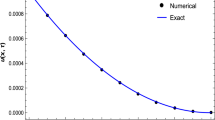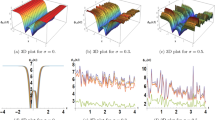Abstract
In this work we study the existence of wave solutions for a scalar reaction-diffusion equation of bistable type posed in a multi-dimensional periodic medium. Roughly speaking our result states that bistability ensures the existence of waves for both balanced and unbalanced reaction term. Here the term wave is used to describe either pulsating travelling wave or standing transition solution. As a special case we study a two-dimensional heterogeneous Allen–Cahn equation in both cases of slowly varying medium and rapidly oscillating medium. We prove that bistability occurs in these two situations and we conclude to the existence of waves connecting \(u = 0\) and \(u = 1\). Moreover in a rapidly oscillating medium we derive a sufficient condition that guarantees the existence of pulsating travelling waves with positive speed in each direction.
Similar content being viewed by others
References
Angenent, S.B., Mallet-Paret, J., Peletier, L.A.: Stable transition layers in a semilinear boundary value problem. J. Differ. Equ. 67, 212–242 (1987)
Agmon, S.: On positivity and decay of solutions of second order elliptic equations on Riemannian manifolds. In: Methods of Functional Analysis and Theory of Elliptic Equations (Naples, 1982), pp. 19–52. Liguori, Naples (1983)
Aronson, D.G., Weinberger, H.F.: Multidimensional nonlinear diffusions arising in population genetics. Adv. Math. 30, 33–76 (1978)
Berestycki, H., Hamel, F.: Front propagation in periodic excitable media. Commun. Pure Appl. Math. 55, 949–1032 (2002)
Berestycki, H., Hamel, F.: A note on uniform pointwise space-gradient estimates up to the boundary for elliptic regularizations of parabolic equations. Commun. Partial Differ. Equ. 30, 139–156 (2005)
Berestycki, H., Hamel, F., Nadin, G.: Asymptotic spreading in heterogeneous diffusive media. J. Funct. Anal. 255, 2146–2189 (2008)
Berestycki, H., Nirenberg, L.: Travelling fronts in cylinders. Ann. Inst. H. Poincaré Anal. Non Lin. 9 497–572 (1992)
Berestycki, H., Nirenberg, L., Varadhan, S.R.S.: The principal eigenvalue and maximum principle for second-order elliptic operators in general domains. Commun. Pure Appl. Math. 47, 47–92 (1994)
Dancer, E.N.: Stable and finite Morse index solutions on \({\mathbb{R}}^n\) or on bounded domains with small diffusion. Trans. Am. Math. Soc. 357, 1225–1243 (2005)
Debieve, C., Duchon, M., Duhoux, M.: Helly’s Theorem in Banach lattices. Busefal 75, 101–109 (1998)
Le Guilcher, A.: Méthode de propagation de fronts. PhD Univ, Paris-Est (2014)
De La Llave, R., Valdinoci, E.: Multiplicity results for interfaces of Ginzburg-Landau-Allen-Cahn equations in periodic media. Adv. Math. 215, 379–426 (2007)
Ding, W., Hamel, F., Zhao, X.-Q.: Bistable pulsating fronts for reaction-diffusion equations in a periodic habitat (preprint)
Ducrot, A., Giletti, T., Matano, H.: Existence and convergence to a propagating terrace in one-dimensional reaction-diffusion equations. Trans. Am. Math. Soc. 366, 5541–5566 (2014)
Fang, J., Zhao, X.-Q.: Bistable traveling waves for monotone semiflows with applications. J. Eur. Math. Soc. 17, 2243–2288 (2015)
Fife, P.C.: Semilinear elliptic boundary value problems with small parameters. Arch. Rational Mech. Anal. 52, 205–232 (1973)
Fife, P.C., McLeod, J.B.: The approach of solutions of non-linear diffusion equations to traveling front solutions. Arch. Rational Mech. Anal. 65, 335–361 (1977)
Gilbarg, D., Trudinger, N.S.: Elliptic Partial Differential Equations of Second Order. Springer, Berlin (1983)
Hamel, F., Omrani, S.: Existence of multidimensional travelling fronts with a multistable nonlinearity. Adv. Differ. Equ. 5, 557–582 (2000)
Liang, X., Zhao, X.-Q.: Asymptotic speeds of spread and traveling waves for monotone semiflows with applications. Commun. Pure Appl. Math. 60, 1–40 (2007)
Liang, X., Zhao, X.-Q.: Spreading speeds and traveling waves for abstract monostable evolution systems. J. Funct. Anal. 259, 857–903 (2010)
Meyer-Nieberg, P.: Banach Lattices. Universitext, Springer, Berlin (1991)
Nadin, G.: The effect of Schwarz rearrangement on the periodic principal eigenvalue of a nonsymmetric operator. SIAM J. Math. Anal. 41, 2388–2406 (2010)
Nagumo, J., Yoshizawa, S., Arimoto, S.: Bistable transmission lines. IEEE Trans. Circuit Theory 12, 400–412 (1965)
Schaefer, H.H.: Banach Lattices and Positive Operators. Springer, Berlin (1974)
Shigesada, N., Kawasaki, K., Teramoto, E.: Traveling periodic waves in heterogeneous environments. Theor. Popul. Biol. 30, 143–160 (1986)
Volpert, A., Volpert, V.: Existence of multidimensional travelling waves and systems of waves. Commun. Partial Differ. Equ. 26, 421–459 (2001)
Volpert, A.I., Volpert, V., Volpert, V.A.: Traveling wave solutions of parabolic systems. Translation of Mathematical Monographs, vol. 140. AMS, Providence (1994)
Xin, X.: Existence and uniqueness of travelling waves in a reaction-diffusion equation with combustion nonlinearity. Indiana Univ. Math. J. 40, 985–1008 (1991)
Xin, X.: Existence and stability of travelling waves in periodic media governed by a bistable nonlinearity. J. Dyn. Differ. Equ. 3, 541–573 (1991)
Xin, J.X.: Existence of planar flame fronts in convective-diffusive periodic media. Arch. Rational Mech. Anal. 121, 205–233 (1992)
Xin, J.X.: Existence and nonexistence of traveling waves and reaction-diffusion front propagation in periodic media. J. Stat. Phys. 73, 893–926 (1993)
Acknowledgments
The author would like to thank the anonymous reviewers for their valuable comments which helped to improve the manuscript.
Author information
Authors and Affiliations
Corresponding author
Appendices
Appendix A: Weak limit of rapidly oscillating functions
When \(g\in L^\infty (\mathbb {T}^N)\) then setting \({\mathcal {M}}(g)=\int _{\mathbb {T}^N}g(x)dx\), it is well known that
In this appendix we aim to show that under some regularity conditions, the above convergence is in some sense uniform with respect to \(\mathbb {T}^N\)-translations. Our result reads as:
Lemma 6.1
Let \(g\in C(\mathbb {T}^N)\) be a given function. Then the following convergence holds true: For all \(\phi \in L^1(\mathbb {R}^N)\), for all \(\eta >0\) there exists \(\delta >0\) such that
Proof
Let \(g\in C (\mathbb {T}^N)\) be given. We denote for each \(h\ge 0\) the quantity
Since g is continuous and \({\mathbb {Z}}^N\)-periodic, it is uniformly continuous so that
To proceed to the proof of the lemma, let us argue by contradiction by assuming that there exists \(\phi _0\in L^1(\mathbb {R}^N)\), \(\eta _0>0\) and a sequence \(\{h_n\}_{n\ge 0}\subset [0,1]^N\) and \(\{\varepsilon _n\}_{n\ge 0}\subset (0,\infty )\) tending to 0 as \(n\rightarrow \infty \) such that
Since \([0,1]^N\) is compact one may assume that \(h_n\rightarrow h_\infty \in [0,1]^N\). Now note that one has for each \(n\ge 0\):
However on the one hand one has
Since \(\Vert h_n-h_\infty \Vert \rightarrow 0\) as \(n\rightarrow \infty \) and recalling (53), one obtains that
On the other hand, recalling that \(\varepsilon _n\rightarrow 0\) as \(n\rightarrow \infty \), one gets from (52) that
These two limits contradict (54) and this completes the proof of the lemma. \(\square \)
As a direct corollary one obtains the following result:
Corollary 6.2
Let \(g\in C (\mathbb {T}^N )\) be a given function. Let \(\{h_n\}_{n\ge 0}\subset \mathbb {T}^N\) be a given sequence and \(\{\varepsilon _n\}_{n\ge 0}\subset (0,\infty )\) be a sequence tending to 0 as \(n \rightarrow \infty \) Then one has:
Appendix B: A non-existence result of standing transition waves
In this section we will discuss the statement of Remark 1.11. To that aim we consider a rather specific nonlinear diffusion equation of the form
posed for \(x= (x_1,{\tilde{x}} )\in \mathbb {R}\times \mathbb {R}^{N-1}\) and for some integer \(N\ge 2\). In this appendix we derive a sufficient condition ensuring that (55) does not admit any standing transition in the direction \(e_0= (1,0_{\mathbb {R}^{N-1}} )\in {\mathbb {S}}^{N-1}\), the direction orthogonal to the heterogeneity. Then this result will be applied to the case of Problem (9) with a periodic row structure to obtain the results stated in Remark 1.11. For that purpose we assume that:
Assumption 7.1
The function \(F\equiv F ({\tilde{x}},u):\mathbb {R}^{N-1}\times \mathbb {R}\rightarrow \mathbb {R}\) is continuous, \(C^\gamma \) (for some \(\gamma \in (0,1)\)) in x uniformly with respect to \(u \in \mathbb {R}\), of the class \(C^1\) in u uniformly with respect to \(x\in \mathbb {T}^N\) and \(F_u\) is continuous on \(\mathbb {T}^N \times \mathbb {R}\). It furthermore satisfies:
-
(i)
\(F({\tilde{x}}, 0 )\equiv F ({\tilde{x}}, 1)\equiv 0\);
-
(ii)
for any \(u\in \{0,1\}\), \(\displaystyle \sup _{{\tilde{x}}\in \mathbb {R}^{N-1}}F_u ({\tilde{x}},u )<0\);
-
(iii)
there exists a sequence \(R_n\rightarrow \infty \) such that
$$\begin{aligned} \lim _{n\rightarrow \infty } \frac{1}{\left| B_{R_n}^{N-1}\right| }\int _{B_{R_n}^{N-1}} W\left( {\tilde{x}},1\right) d{\tilde{x}}\ne 0, \end{aligned}$$wherein we have set \(W({\tilde{x}},u )=\int _0^u F ({\tilde{x}},s)ds\). Moreover for each \(R>0\), \(B_R^{N-1}\subset \mathbb {R}^{N-1}\) denotes the ball in \(\mathbb {R}^{N-1}\) with the radius \(R>0\) and centered at the origin while \(|B_{R}^{N-1}\vert \) denotes its measure in \(\mathbb {R}^{N-1}\).
Under the above set of assumptions we will prove that the following proposition holds true.
Proposition 7.2
Let Assumption 7.1 be satisfied. Then Problem (55) does not admit any standing transition between \(u=0\) and \(u=1\) in the direction \(e_0\).
Proof
In order to prove the above proposition, let us assume that there exists a standing transition \(u:\mathbb {R}^N\rightarrow \mathbb {R}\) connecting \(u=0\) and \(u=1\) in the direction \(e_0\), that is a function \(u\equiv u (x_1,{\tilde{x}} )\) satisfying the equation
as well as the following behaviours when \(x_1\rightarrow \pm \infty \):
Here the above limits are uniform with respect to \({\tilde{x}}\in \mathbb {R}^{N-1}\).
Now because of Assumption 7.1 (ii) one obtains the following exponential decay with respect to \(x_1\): there exist some constants \(C>0\) and \(\eta >0\) such that for all \(x= (x_1,{\tilde{x}})\in \mathbb {R}^N\) one has
We refer for instance to [7, 16] for the derivation of such an exponential decay.
Let us also observe that due to elliptic estimates and the uniform limits in (57) one has:
Let \(M>0\) and \(R>0\) be given and fixed. Multiplying (56) by \(\partial _{x_1} u\) and integrating over the cylinder \((-M,M)\times B_R^{N-1}\) yields
In the second line of the above computation, \({\tilde{\nu }}({\tilde{x}})\in \mathbb {R}^{N-1}\) denotes the outward unit vector to \(\partial B_R^{N-1}\subset \mathbb {R}^{N-1}\) at \({\tilde{x}}\).
Now using the properties stated in (58) and (59) one can let \(M\rightarrow \infty \) in the above formula to obtain that for each \(R>0\):
Therefore there exists some constant \(K>0\) such that for all \(R>0\) one has
This former property contradicts Assumption 7.1 (iii) and this completes the proof of Proposition 7.2. \(\square \)
We now come back to Problem (9) with \(r(x)=r(x_2)\) and \(a(x)=a(x_2)\) for all \(x= (x_1,x_2 )\in \mathbb {T}^1\times \mathbb {T}^1\). Then the function \(f(x,u)=r(x_2)u (u-a(x_2)) (1-u)\) satisfies the conditions of Assumption 7.1 (i) and (ii) and one has
with \({\mathcal {M}}(r)=\int _{\mathbb {T}^1} r(x_2)dx_2\) and \(\overline{\theta }=\frac{\int _{\mathbb {T}^1} r(x_2)a(x_2)dx_2}{{\mathcal {M}}(r)}\). Hence in that context Assumption 7.1 (iii) is equivalent to \(\overline{\theta }\ne \frac{1}{2}\). This condition is satisfied under the assumptions of Theorem 1.9 while under the assumptions of Theorem 1.10 this condition has to be furthermore assumed. This completes the proof of the statements in Remark 1.11.
Rights and permissions
About this article
Cite this article
Ducrot, A. A multi-dimensional bistable nonlinear diffusion equation in a periodic medium. Math. Ann. 366, 783–818 (2016). https://doi.org/10.1007/s00208-015-1349-y
Received:
Revised:
Published:
Issue Date:
DOI: https://doi.org/10.1007/s00208-015-1349-y




